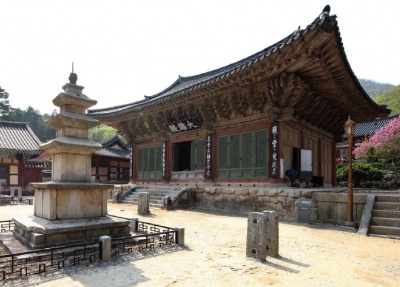"Korea's Religious Places - 1.1.8 Seonamsa Temple (Suncheon, Jeollanam-do)"의 두 판 사이의 차이
잔글 (→Seonamsa Temple (Suncheon, Jeollanam-do)) |
잔글 |
||
| 1번째 줄: | 1번째 줄: | ||
| + | {{Navbox | ||
| + | |서명= [[Understanding Korea materials - Korea's Religious Places|Korea's Religious Places]] | ||
| + | |시리즈명= [[한국이해자료#Understanding Korea Series|Understanding Korea Series No.6]] | ||
| + | |이전= [[Korea's Religious Places - 1.1.7 Magoksa Temple (Gongju, Chungcheongnam-do)|* Magoksa Temple (Gongju, Chungcheongnam-do)]] | ||
| + | |현재= [[Korea's Religious Places - 1.1.8 Seonamsa Temple (Suncheon, Jeollanam-do)|* Seonamsa Temple (Suncheon, Jeollanam-do)]] | ||
| + | |다음= [[Korea's Religious Places - 1.1.9 Daeheungsa Temple (Haenam, Jeollanam-do)|* Daeheungsa Temple (Haenam, Jeollanam-do)]] | ||
| + | }} | ||
| + | |||
| + | |||
==Seonamsa Temple (Suncheon, Jeollanam-do)== | ==Seonamsa Temple (Suncheon, Jeollanam-do)== | ||
| 16번째 줄: | 25번째 줄: | ||
As one approaches the temple, there is a beautiful stone bridge, like a rainbow in a half-circle formation. It is absolutely beautiful, and the first of two such bridges on the mile-long trail that leads to the temple. Like so many of the major temples, the approach, climbing a path alongside a rippling stream, leads to the temple in a scenic canyon in the picturesque mountains of Korea. | As one approaches the temple, there is a beautiful stone bridge, like a rainbow in a half-circle formation. It is absolutely beautiful, and the first of two such bridges on the mile-long trail that leads to the temple. Like so many of the major temples, the approach, climbing a path alongside a rippling stream, leads to the temple in a scenic canyon in the picturesque mountains of Korea. | ||
| + | |||
| + | |||
| + | {{틀:UKS Korea's Religious Places}} | ||
2017년 1월 20일 (금) 14:11 기준 최신판
| Understanding Korea Series No.6 | ||
| ← Previous | Korea's Religious Places | Next → |
| * Magoksa Temple (Gongju, Chungcheongnam-do) | * Seonamsa Temple (Suncheon, Jeollanam-do) | * Daeheungsa Temple (Haenam, Jeollanam-do) |
Seonamsa Temple (Suncheon, Jeollanam-do)
Located in Jeollanam-do, near Suncheon, lies Seonamsa Temple, the “Temple of the Rock of the Immortals”—said to have been so named because immortals were known to play baduk (go) on a rock there. In that connection it is one of the three so-called rock temples—with “Cloud Rock Temple” (Unamsa Temple) and “Dragon Rock Temple” (Yongamsa Temple). Am (![]() m/) means rock or large boulder. More important, however, Seonamsa Temple is the headquarters and monastic training center for the Taego Order of Buddhism, the married order.
m/) means rock or large boulder. More important, however, Seonamsa Temple is the headquarters and monastic training center for the Taego Order of Buddhism, the married order.
It is interesting that just over the mountain sits Songgwangsa Temple, the main monastic training center for the Jogye Order. At Seonamsa Temple, there are monastics (male and female) who are married—there is freedom of choice to marry or not. Although the celibate order has more monks—they outnumber the married monks by approximately ten to one—there are a significant number of temples around the country that belong to the Taego Order.
Historically, Seonamsa Temple is tied to the famous monk-geomancer Doseon (827–898) of the late Unified Silla period, although it is thought that the site was the location of a hermitage that dates back even earlier, to the Three Kingdoms period.
Seonamsa Temple is characterized as a feminine temple, particularly in contrast to Songgwangsa Temple, on the other side of Mt. Jogyesan, which is a more masculine temple. Certainly, Seonamsa Temple has a warmer, friendlier atmosphere in that the buildings are smaller and closer together with manicured gardens in the various courtyards between buildings.
- Daeungjeon Hall and a stone bridge at Seonamsa Temple
As one approaches the temple, there is a beautiful stone bridge, like a rainbow in a half-circle formation. It is absolutely beautiful, and the first of two such bridges on the mile-long trail that leads to the temple. Like so many of the major temples, the approach, climbing a path alongside a rippling stream, leads to the temple in a scenic canyon in the picturesque mountains of Korea.
